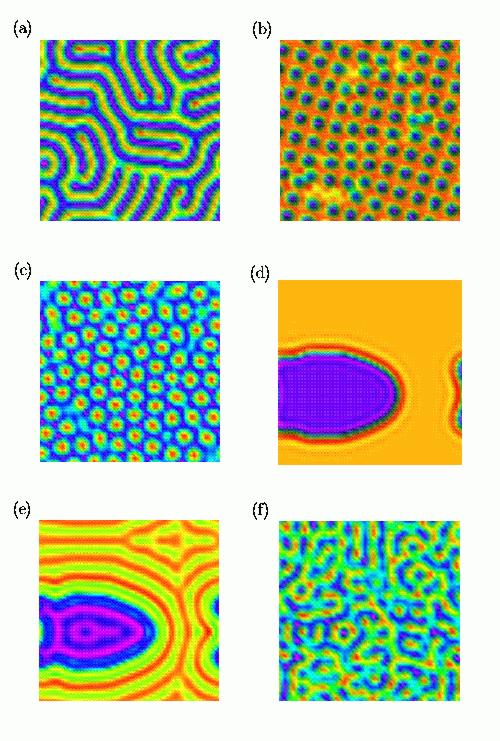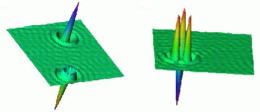Pattern formation is an ubiquitous phenomenon in the dynamics of extended nonlinear systems [CH93,GL99]. Patterns in extended systems arise as a result of the interplay of many factors including nonlinearities, external forcing and/or excitability of the medium, spatial interactions, and internal dissipation.
Motivated by experiments on vibrated granular layers by Paul Umbanhowar and coworkers at the Center for Nonlinear dynamics, we recently introduced Continuum Coupled Maps, a new framework for studying pattern formation in periodically forced systems.
A continuum coupled map (CCM) is a dynamical system defined on the
space of smooth functions
![]() : D
: D ![]()
![]() by
by
The system (CCM) is invariant under translations in space as well as time translations by one unit. For this reason, the CCM framework is useful in modeling periodically forced extended systems which have the same symmetries. This framework is also very convenient for numerical simulations.
We used the Continuum coupled map approach to successfully model recent experiments at U. Texas, on pattern formation in vibrated granular layers [MUS95,UMS96,UMS98]. Using a generic model where Temporal period doubling interacts with pattern formation at a preferred scale, we obtain the spatio-temporal bifurcation phenomena observed in experiment.

The figure shows the phase diagram that we obtain from our model. Our model is a generic model for pattern forming systems that have period doubling and is similar in spirit to the Swift-Hohenberg and the Complex Ginzburg-Landau Equations. It is not tied to the physics of any specific experiment and the features that it reproduces can be thought of as being universal in systems with interacting temporal period doubling and spatial pattern formation.

Extended patterns in our model. (a) Period 2 Stripes. (b) Period 2 Squares (c) Period 2 Hexagons (d) Period 2 flat state with a front. (e) Period 4 stripes (f) Disorder.

Localized patterns in our model. (a) Two oscillons in opposite temporal phases. (b) A bound state of oscillons with coordination number 3
Using the CCM approach with a map that has a coexisitng stable periodic orbit and a chaotic attractor, we investigated the propagation of fronts between domains of spatio-temporal chaos and homogeneous steady states [KVO+01]. We obtain effective equations for the front and also scaling laws for its roughness using an effective long-wavelength model. These laws are verified by direct numerical simulations on our model. In particular, the chaos plays the same role in the roughening of the front, as noise in the Kardar-Parisi-Zhang equation []. Also, the ``averaged'' front forms finite time singularities (cusps) consistent with predictions of the long wavelength model.
Pattern formation is intrinsically a multiple scale phenomenon, since
it results from an interplay of many different physical processes,
each acting on different spatial/temporal scales. In our model for
vibrated granular layers [VO98,VO01], we take
D = [0, L] x [0, L], the initial function
![]() (x) =
(x) = ![]() +
+ ![]()
![]() (x), where
(x), where
![]() is an order 1 constant,
is an order 1 constant,
![]()
![]() 1 is small, and
1 is small, and ![]() is a normalized random
function. By evolving this function according to (CCM) we
observe the following:
is a normalized random
function. By evolving this function according to (CCM) we
observe the following:
We are currently looking at the following question -